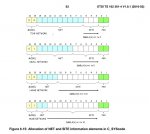Hola amigos, soy nuevo en este foro y quería presentarme, mi nombre es Rafa y tengo una duda en referencia al DSD, es una herramienta que uso a diario, creo que todos o casi todos los que estamos aquí la usamos en sus diferentes versiones.
Mi duda es el porqué se representa en el DSD tanto el área como el sitio de las redes TIII de esa forma, me explico: en el DSD toma los primeros bits correspondientes al sitio para el área según el tipo de red y usa los tres últimos para el sitio salvo en el modelo Tiny, ya que éste tiene sólo tres bits y por tanto toma uno para el área y dos para el sitio.
Según la figura 6.15 del ETSI TS 102361-4 V1.8.1, nos indica el número de bits asignados al sitio y al DMRLA (DMR Local Area) que puede ser desde 1 hasta un número igual al de bits que usa para el sitio según el modelo de red.
Espero que alguien me pueda resolver esta duda y la forma de solucionarlo o, en su defecto, que si tengo razón en mi planteamiento se podría resolver en futuras versiones del DSD.
Gracias por vuestra colaboración.
Mi duda es el porqué se representa en el DSD tanto el área como el sitio de las redes TIII de esa forma, me explico: en el DSD toma los primeros bits correspondientes al sitio para el área según el tipo de red y usa los tres últimos para el sitio salvo en el modelo Tiny, ya que éste tiene sólo tres bits y por tanto toma uno para el área y dos para el sitio.
Según la figura 6.15 del ETSI TS 102361-4 V1.8.1, nos indica el número de bits asignados al sitio y al DMRLA (DMR Local Area) que puede ser desde 1 hasta un número igual al de bits que usa para el sitio según el modelo de red.
Modelo de red Huge: 2 bits para el modelo (11), 2 bits para la identificación de la red y 10 bits para la identificación del sitio, el área puede ser desde 1 bit hasta 10 bits.
Modelo de red Large: 2 bits para el modelo (10), 4 bits para la identificación de la red y 8 bits para la identificación del sitio, el área puede ser desde 1 bit hasta 8 bits.
Modelo de red Small: 2 bits para el modelo (01), 7 bits para la identificación de la red y 5 bits para la identificación del sitio, el área puede ser desde 1 bit hasta 5 bits.
Modelo de red Tiny: 2 bits para el modelo (00), 9 bits para la identificación de la red y 3 bits para la identificación del sitio, el área puede ser desde 1 bit hasta 3 bits.
En la figura 6.18 del mismo ETSI nos presenta un ejemplo de cómo sería esa relación de bits entre el sitio y el área, indica como ejemplo que el DMRLA sería equivalente a 6 bits, pero en ningún momento le resta bits al sitio.Usa el modelo de red Large (10) con 4 bits para la identificación de la red, 8 bits para la identificación del sitio e indica que el DMRLA es 6 bits, en el ejemplo no resta estos 6 bits a los 8 bits de la identificación del sitio.
Por este motivo me surge esta duda en relación al DSD, me gustaría saber si es posible, el motivo por el cual en el DSD se le resta al sitio estos bits en beneficio del área y que el área sea siempre el mismo número de bits según mar el modelo de red.Espero que alguien me pueda resolver esta duda y la forma de solucionarlo o, en su defecto, que si tengo razón en mi planteamiento se podría resolver en futuras versiones del DSD.
Gracias por vuestra colaboración.



